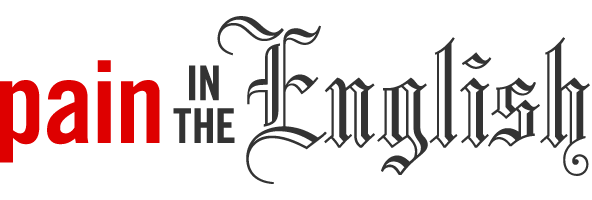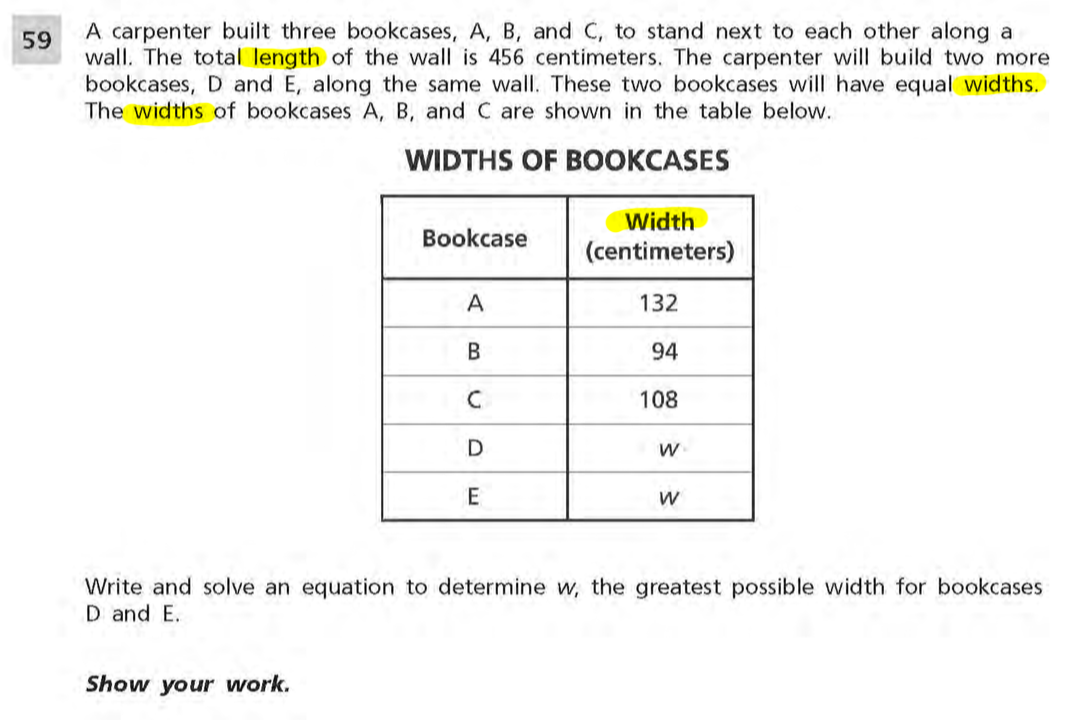Proofreading Services Retired
We’ve officially closed our proofreading services. You can probably guess why. With AI tools like ChatGPT now doing the job for free (and instantly), the demand for human proofreaders has all but vanished. If you still prefer a human touch, you're part of a rare—and shrinking—breed. We're now back to our roots: a forum for nitpicking the finer points of the English language. Thanks for your past support. We appreciate it.
Submit your question here.
Latest Posts : Etymology / History
I had never thought I would ever wonder what “width” is until my 12-year old daughter came home one day and told me that her math teachers (not just one but two) told her that “width” in geometry is the vertical side of a rectangle. That to me was like saying up is down and down is up. How could this be?
It turns out that her teachers are not alone. Take a look at this page I came across while Googling on the topic. It says:
In the case of a square or a rectangle, the expression length (1) is commonly used instead of base and width (w) instead of height. In the case of a circle the expression diametre (d) is used.

“Width instead of height” is very much like saying up is down. Where did this come from?
And, what is even more disconcerting is that the teachers are not aware of this ambiguous nature of “width.” Two other teachers told me that width is always the horizontal side, and another told me that she has heard others call the vertical side “width.” So, apparently, each is teaching their students in an authoritative manner their own definition of “width.” If a 12-year old is told by her math teacher that “width” in geometry refers to the vertical side, why should she doubt it? Unless, of course, she was also told that “width” can be vertical or horizontal (i.e. direction neutral, like “length”). But that is apparently not what is happening at school in New York City.
If we teach our kids that a triangle has three sides, we don’t want them thinking that the definition of “triangle” could be flexible as if it could have four or five sides. If the definition of “width” is not universal, they need to know that. Here is a case in point. The following question was in 2016 Common Core Math Test for Grade 6.
“A carpenter built three bookcases, A, B, and C, to stand next to each other along a wall. The total length of the wall is 456 centimeters. The carpenter will build two more bookcases, D and E, along the same wall. These two bookcases will have equal widths. The widths of bookcases A, B, and C are shown in the table blow.”
Now, if you were taught that in geometry, “width” means the vertical side and “length” means the horizontal side, you would have to be confused reading this question. The correct response would be, “But why should the ‘widths’ of the bookcases have anything to do with the ‘length’ of the wall in fitting the bookcases?”
My daughter tried to figure this out by drawing a bunch of bookshelves with different heights, and eventually gave up because the question made no sense to her.
In Merriam-Webster, the word “width” has no ambiguity: “the horizontal measurement taken at right angles to the length.” After all, the word “height” has no ambiguity, so why should we think “width” would?
But looking at the Oxford dictionary gives us a slightly different answer: “The measurement or extent of something from side to side; the lesser of two or the least of three dimensions of a body.”
In other words, in a rectangle, “the lesser of the two” sides would be called “width” regardless of the orientation. So, it appears that this is an American-versus-British issue, or is it? (Note the spelling of “diametre” on the page from fao.org quoted above.)
I have searched the forum and not found any reference to this matter. More and more, I’m hearing this kind of construction: “The fact of the matter is is that we need to...” or “The biggest problem is is that we don’t have...” I’ve even heard President Obama use it. At first blush, it bothers me. There’s no need for the second “is,” and no grammatical precedent. That is to say, I don’t know what it might spill over from. Furthermore, it seems like a fairly recent arrival. What do you think? Is this something we should eschew or embrace? Has anyone else heard and taken note of this?
What is the origin of the phrase “I’m just saying”?
Can anyone tell me when and how the adding of “ish” to the end of words got started? Do we lack such confidence in ourselves that we need to add “ish” like a disclaimer to our own words? When has the word become not word enough?
When did “issue” come to mean “problem” ?
When an why did “exactly the same” become “the exact same” and more recently “the same exact”?
There exists a claim that the word “man” originally only referred to people of unimplied sex. To restate, “man” always refereed to both male and female people.
The claims I found were made by sources known by some to be categorically highly unreliable, so I turn to you.
There are claims that “wer” or “were” was used at least for adult males.
The most reliable sources I’ve found to support that are
http://www.collinsdictionary.com/...
What evidence can you provide of the use of “were” or “wer” in english and the use of “man” and whether “man” changed over time with respect to gender or whether there was always ambiguity?
I just have the impression that the old proverbs that I heard as a child aren’t heard as much today. People just don’t seem to use them much anymore.
Of course this is hard to prove: maybe I am not mixing in the right circles; maybe there are newer proverbs that have replaced the older (proverbs change with each generation); maybe the media and/or gurus have picked up some and ignored others; maybe few make into print outside the tabloids and popular magazines.
As far as the printed word goes, of those I have looked at some seem to peak around the 1930′s and then trail off, only to recover somewhat over the last decade or two. “Actions speak louder than words” was the commonest one I found, 3:1 against “Beggars can not be choosers”.
What is your impression? Is proverb use declining or just new ones becoming popular?
More and more lately I’ve been hearing and seeing a change in the prepositions used in common phrases.
I’ve already commented on PITE about the use of “deal to” instead of “deal with” in NZ, and of course we have the age old debate about “different from/to”.
Recently I noticed some others creeping in:-
“what do you make to....” instead of “what do you make make of .....”
“I have no intention on.......” instead of “I have no intention of......”.
I’m sure there are others.
While there may be nothing grammatically wrong in this, it does sound a little strange and raises the question of why and how such usage arises.
Does it stem from a desire to be different just for the sake of being different?
Is it down to some kind of narcissism?
. when saying “what reading
Will words like fæces, archæologist, fœtus disappear from our language or should they be preserved?
Latest Comments
Treatment of abbreviations and superscript items in full capital case
- jacklin123
- December 4, 2025, 6:51am
This really captures the spirit of why a Happy birthday ecard is special — heartfelt, meaningful, and full of genuine emotion.
https://sendwishonline.com/en/group-cards/happy-birthday-cards
Treatment of abbreviations and superscript items in full capital case
- jacklin123
- December 4, 2025, 6:45am
It’s amazing how a thoughtful birthday invitation card can create anticipation and make guests feel included.
Treatment of abbreviations and superscript items in full capital case
- lirox95470
- December 3, 2025, 11:48pm
NURS FPX 6222 Assessment 1
A simple, step-by-step guide to completing NURS FPX 6222 Assessment 1 with clear instructions and rubric-focused tips.
NURS FPX 6222 Assessment 3
Master NURS FPX 6222 Assessment 3 with an easy explanation, example structure, and strategies to score higher.
NURS FPX 6226 Assessment 1
A complete walkthrough for NURS FPX 6226 Assessment 1, including key requirements, formatting help, and APA guidance.
NURS FPX 6222 Assessment 1
A simple, step-by-step guide to completing NURS FPX 6222 Assessment 1 with clear instructions and rubric-focused tips.
NURS FPX 6222 Assessment 3
Master NURS FPX 6222 Assessment 3 with an easy explanation, example structure, and strategies to score higher.
NURS FPX 6226 Assessment 1
A complete walkthrough for NURS FPX 6226 Assessment 1, including key requirements, formatting help, and APA guidance.
Treatment of abbreviations and superscript items in full capital case
- lirox95470
- December 3, 2025, 11:44pm
NURS FPX 4025 Assessment 2
A complete guide to NURS FPX 4025 Assessment 2 with easy steps, rubric tips, and scoring strategies.
NURS FPX 4025 Assessment 3
Learn how to complete NURS FPX 4025 Assessment 3 with clear examples, writing help, and APA guidance.
NURS FPX 4025 Assessment 4
Master NURS FPX 4025 Assessment 4 with a detailed walkthrough, top solutions, and professional writing support.
nowadays business?
- Johny1996
- November 28, 2025, 9:58am
Grammar can be tricky, especially when it comes to understanding why certain rules exist.
nowadays business?
- Johny1996
- November 28, 2025, 9:58am
Grammar can be tricky, especially when it comes to understanding why certain rules exist. I’ve been improving my content presentation skills with a great tool called Decksy AI. It helps me organize my thoughts and present them more clearly. If you’re tackling grammar topics and want to make your presentation look sharp and organized, Decksy AI is worth a try! It’s super easy to use and can make your explanations much more engaging.
couple vs couple of
- Paddybee
- November 24, 2025, 5:50am
The preposition must be included. One does not write "a pride lions' or 'a slice bread' or 'a bucket water'. Omitting 'of' is simply wrong
“I have two sons, Bill and Ben”: comma or colon?
- Paddybee
- November 24, 2025, 5:33am
Have you considered that using the comma indicates you are addressing two people named Bill and Ben, not specifying these names as being your sons,? A colon removes this ambiguity
“my” vs. “mine” in multiple owner possessive
- eztotap
- November 22, 2025, 6:40am
This is a clear and helpful explanation of how ‘my’ and ‘mine’ work, especially in multiple-owner situations. Grammar topics like this can be tricky, but your breakdown makes it easy to understand. For anyone who enjoys learning and sharing useful information online, tools like EztoTap make digital sharing smooth, quick, and secure.






You’re not going to the game, are you?
I’ve always found discussions about grammar rules fascinating because language evolves so naturally that what feels “wrong” today might be accepted tomorrow. The whole debate about verb agreement reminds me how important context is. I once came across a clear and simple explanation on casino support https://pin-up.world/faq not about grammar, but about how clarity can completely change how you see things. It’s funny how the right wording (or question) makes complicated stuff suddenly make sense.